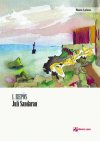Barcelona (1914-1995), pianist and composer. He studied piano with Pere Vallibera and composing with Antoni Massana, pupil of Enric Morera and Enric Granados, and Cristòfor Taltabull, pupil of Max Reger. A. Massana passed on to him a liking for Catalan folk music, as well as for Wagner and Debussy. And Taltabull transmitted hi a liking for Brahms and Hindemith.
After finishing his studies, Juli Sandaran Sambeat became interested in jazz and improvisation following the models of those days. He became one of the importers of this genre in Catalunya, leading orchestras, quartets and trios in several pubs of Barcelona. From the sixties onward, he was one of the principle pianists of the Barcelona Jamboree Jazz Club, where he took turns with the Tete Montoliu Trio amongst others. One of the characteristics of his personality was his fight for the equal treatment of jazz and the so-called classical music. The most important thing to him was that it was good music. He took part in the first jazz festival of Barcelona (1966) and played with prominent jazz musicians such as Emil Beckman, Lou Bennett, Bill Coleman and Stephane Grappelli.
He also participated actively in the trend called Nova Cançó. He cultivated very different genres that range from songs (voice and piano), harmonisations and arrangements of folksongs, chamber music for different formations (duos, trios, quartets) religious music, sardanas and music for theatre and television.
Especially outstanding is his “Suite for twelve violoncellos”, which was interpreted and conducted by the cellist Lluís Claret. Furthermore, an oratorio for choir, organ and string quartet or little orchestra, six sardanas, the musical comedy “El Roig I el Blau” with texts by Joan Oliver (Pere Quart), the music to some of the characters of Joan Oliver’s “Bestiari”, the play “El brunzir de les abelles” by Rodolf Sirera and several pieces for the Catalan TV production of TV2 “Terra d’escudella” (1978) are to be pointed out.
His music shows a clear influence of Catalan music, expressed in beautiful melodies, and of jazz, expressed in its harmonic structure. You may consult “El jazz a Catalunya”, Edicions 62, Barcelona (1985), by Alfredo Pappio, and “Jazz en Barcelona 1920-1965”, Editorial Almendra Music (2005), by Jordi Pujol Baulenas.















